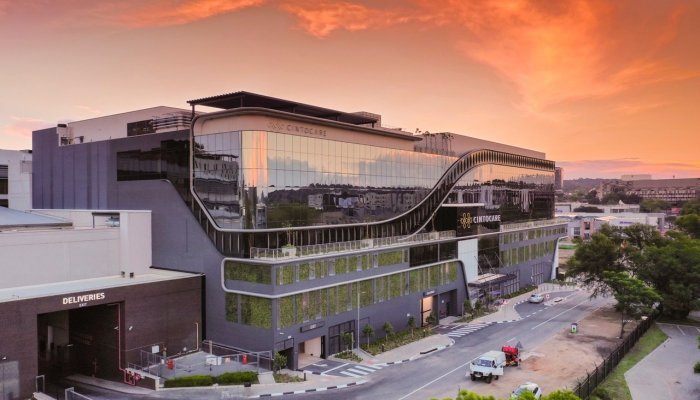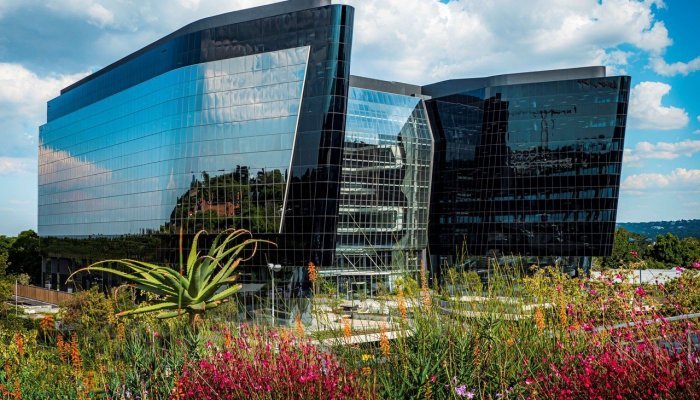The global real estate industry accounts for about 40% of annual greenhouse gas emissions, according to the United Nations (UN), which contribute to climate change – the shifts in temperatures and weather patterns over the years.
Green buildings or environmentally friendly buildings can help address and reduce the effects of climate change, improve the health and wellbeing of occupants as well as help owners lower building operational costs.
“Climate change will affect everyone and action is needed. Though the built environment is part of the problem, it can also be a huge part of the solution,” says Georgina Smit, head of technical at the Green Building Council of South Africa (GBCSA).
The GBCSA is an industry body that collaborates with professionals to champion climate action on new and existing buildings. Its role is to drive market transformation within the South African built environment.
“At GBCSA, we strongly believe in the practical solutions that can be measured and that demonstrate a significant impact that green and net zero buildings offer.” Net zero refers to buildings with close to zero greenhouse gas emissions.
Industry initiatives
Globally, the World Green Building Council (WorldGBC) has acknowledged that the built environment is a problem, but also presents an opportunity to correct the situation. To this end, the organisation, together with regional councils, has committed to not only build sustainably but has set itself ambitious targets to reduce its carbon emissions.
Worldwide, the built environment aims to achieve net-zero operational carbon emissions between 2030 and 2050. These buildings are optimally (energy) efficient, they generate their own energy onsite using clean renewable resources (like solar power), in amounts equal or greater than the total energy consumption on site.
The South African built environment is doing its part to reduce carbon emissions, as seen in the number of green-certified buildings in line with these global ambitions. The GBCSA sets standard benchmarks around energy performance in buildings that support climate change mitigation for all industry stakeholders to measure themselves against.
Smit says the GBCSA was a key partner in bringing the net zero carbon conversation to South Africa, and the country has more than 20 buildings that have achieved net zero carbon, including big buildings. “These buildings provide examples of leadership, innovation and practical real-life solutions at delivering buildings that are at the forefront of tackling climate change.”
In partnership with the American Society of Heating, Refrigerating and Air-Conditioning Engineers (ASHRAE) and the eThekwini Energy Office, with input from the C40 South Africa Buildings Programme, Sustainable Energy Africa (SEA), the GBCSA has also developed a guide to developing net zero carbon buildings in South Africa – a tool providing a user-friendly overview on net zero carbon buildings.
Zero carbon emissions target
Emira Property Fund is a JSE-listed real estate investment trust, one of 80 companies globally and the only one in Africa, which was selected to work with the SBTi (Science Based Targets Initiative) in 2017 to develop the global net-zero standard to align with the Paris Agreement's 1.5°C carbon reduction target. The target aims to reduce Scope 1 and 2 (emissions owned or controlled by a company) greenhouse gas emissions by 13% by 2023, using 2015 as a base year, says Ulana van Biljon, Emira's chief operating officer at Emira Property Fund.
“To date, Emira has achieved 98.1% of this target, and by 2023, the new target will see Emira reduce its emissions by 46% compared to the 2019 baseline,” says Van Biljon.
For the 2022 financial year, Emira achieved a 3.8% reduction in carbon emissions across its buildings and 2% reduction in Scope 1 and 2 emissions. The company recorded a 2% reduction in grid electricity usage while seeing a 16% increase in energy production.
Its green building in Bryanston, Johannesburg, the Knightsbridge Office Park Block A, achieved Net Zero – Carbon Level 2: Occupant Emissions (modelled) certification. An additional 50 000 litre rainwater harvesting system was installed at its Ben Fleur Shopping Centre in Mpumalanga.
Reducing operational carbon emissions is a key component of all GBCSA green building certification tools. To date, there are more than 900 certifications in South Africa, mainly taken up by the commercial (offices) property sector. Increasingly, the residential property sector and industrial property players are adopting green certifications.
“International studies have shown that green building initiatives focused on energy efficiency are the most cost-effective climate abatement solutions, in comparison to other sectoral options,” says Smit.
Growthpoint Properties, the largest and most liquid real estate investment trust on the JSE and a component of its Top 40 index, has 71 green star-rated buildings out of the 408 buildings it owns. The company aims to have all the buildings it controls to operate at net zero carbon by 2030 and all buildings by 2050.
Grahame Cruickshanks, Growthpoint Properties' head of sustainability and utilities, says they have invested in energy and water efficiency and zero organic waste to landfill, among other initiatives.
He says the company is focused on making its assets less dependent on non-renewable energy sources while actively promoting water security. “We provide space to thrive in environmentally sustainable buildings, while improving the social and material wellbeing of individuals and communities.”
Since 2015, South Africa’s only specialist self-storage real estate investment trust, Stor-Age, has invested more than R170 million installing solar panels in its buildings in South Africa and the United Kingdom, with a further R8 million investment planned over the medium term.
In South Africa, the company has installed more than 2 400 solar photovoltaic (PV) systems at 26 of its buildings and four in the UK. These PV systems have to date generated 2.2-million kilowatt-hours (kWh) in solar power, capable of powering 2 400 homes for a month. Its total solar PV system is about 840kWh.
“We believe that the most important space is the environment that surrounds our properties and the broader communities in which we operate,” says Chris Oosthuizen, chief marketing officer of Stor-Age.
He says Stor-Age will continue investing in energy efficiency, renewable energy generation, reducing CO2 emissions, rainwater harvesting, storm water management, waste and water management, fuel consumption and conservation.
In newly acquired buildings and new developments, Stor-Age installs solar panels and energy efficient LED lighting as well as implementing waste management initiatives.
LED light fittings save up to 60% of consumption compared to standard fittings. In addition, solar panelled hot water cylinders have been installed to heat water within its properties. Monthly reviews are conducted to assess energy consumption across the portfolio.
Renewable energy use has resulted in about a 13% reduction in the total carbon emissions within Stor-Age’s control and results of its activities from other sources but not owned or controlled by the company. More than 1 677 tons of carbon dioxide emissions were avoided through the consumption of on-site solar PV renewable electricity, says Oosthuizen.
“The main energy consumption of our properties is grid electricity for lighting, elevators, general power, heating, cooling and ventilation and these cause indirect off-site power station carbon emissions,” says Oosthuizen.
It starts with sustainable design
Most of the carbon dioxide emissions from the built environment come from the production of concrete, with glass and steel the second- and third-most polluting materials due to high-energy consumption and material off-gassing during fabrication. The balance of the industrial emissions are from shipping and transportation.
“As an industry, and given the urgency to tackle climate change, it is important to do away with unsustainable building practices by using more renewable materials and considering energy consumption during the life cycle of a building,” said Hernes Kruger, director at TNK (ThiNK) Green.
TNK, a multidisciplinary design and lifestyle company, pivoted in 2020 after seeing a gap in the market to move away from standard construction practices to sustainable ways. As an example, the company has moved towards low-embedded energy construction and is actively pursuing education opportunities to become a LEED-certified design and construction firm.
Kruger says TNK advises towards more sustainable construction materials, such as using less concrete, glass and steel, and by making use of cross-laminated timber (CLT), clay and lime plaster, and considering alternatives to standard brick-and-mortar construction wherever possible.
“Construction materials should be carefully considered and in recent years there has been a push towards more sustainable materials such as wood (CLT), stone, hemp (hempcrete), or soil (rammed earth), but most of these have not seen widespread adoption in the South African market,” says Kruger.
Oosthuizen says Stor-Age targets building designs which allow for maximum use of daylight to reduce demand for artificial lighting.
They also use building materials that assist with insulation, source major building materials from responsible local suppliers where possible, minimise construction waste and implement a site waste management plan, harvest rainwater for internal use, implement effective surface water design and management systems, and maintain or enhance each site’s ecological value through retention of vegetation and new plants.
Cost reduction
Van Biljon says the effects of climate change pose a significant risk to operational costs, hence Emira continues to invest in energy efficient and renewable energy across its portfolio. In 2015, Emira began with its first PV farm installation, and has since increased its installed capacity to nine properties equating to nearly 24 000 solar panels and more than 9 000 kilowatt peak capacity.
Between 2015 and 2022, Emira has implemented various sustainability interventions on 554 projects at a cost of R222 million. As a result, 24 088tCO2e (tons of carbon dioxide equivalent) were offset, 23 808 489kWh of electricity and 358 795 kilolitres of water have been saved.
Cruickshanks says resource are becoming scarcer due to climate change, leading to a rise in administered costs. It is becoming rapidly more expensive to purchase electricity generated primarily from fossil fuels, resulting in increasing occupancy costs for tenants – and this puts a strain on their ability to meet their lease obligations, he explains.
“With this in mind, our biggest opportunity is energy efficiency projects like lighting retrofits with shared savings agreements such as a green addendum to leases,” says Cruickshanks.
Going green
Smit says building green enables the efficient use of resources while addressing climate change – and this results in healthier and more productive environments in which people can live, work and play. To achieve this, elements of building design, materials used and technology to reduce energy and resource consumption are incorporated.
“Green buildings produce less waste and carbon emissions, they lower maintenance costs, electricity and water costs, and have lower vacancies compared to traditional buildings.”
The GBCSA has created rating tools that allow building owners to measure buildings' green levels compared to a standard traditional non-green building for new and existing buildings.
The rating tools can be used for any type of building and most projects, from precincts to homes to existing buildings and interior fit-outs, among others. The green star certification creates a universal platform for credible and objective measurement of green buildings. Each tool recognises and rewards environmental leadership and is a recognised symbol of sustainability achievement, Smit explains.
Most new buildings are designed to target a green star rating. Depending on the star rating, the GBCSA has specifications on what each rating looks at as a scorecard. The same applies for existing buildings, where, for example, building owners replace lighting, install water and electricity saving initiatives such as smart metres.
GBCSA achievements to date
The GBCSA, a non-profit membership-based organisation, was established in 2007 by commercial property sector leaders. It is one of about 70 members of the WorldGBC.
Since launching, the GBCSA has achieved 905 green certifications in Africa, across the Green Star, Net Zero, Energy Water Performance and Excellence in Design for Greater Efficiencies categories.
The effect of these certifications has resulted in significant energy and water saving as well as carbon reduction. Some of these include: 91 500 households' worth of annual energy (1 320 million kilowatt-hour/annum), and 1 220 million litres of potable drinking water will be saved annually, which equates to 1 672 800 people’s daily drinking water needs annually. The 1 590 million kiloggrams of CO2 per annum that will be saved equates to 395 400 cars off the roads every year in terms of kg/CO2 equivalent.
To date, 2 265 professionals have been accredited through GBCSA’s training and accreditation programmes, with 325 students going through the candidate programme.
The CEO of GBCSA, Lisa Reynolds, says that in 2022, 165 buildings were certified.
“It took over five years to achieve the first 50 certifications, but as the environmental and financial benefits of green building became more apparent, we saw a greater buy-in across the board and the industry as a whole has shifted.”
Reynolds says it is recommended that net zero-ready building standards covering the life cycle emissions of buildings are implemented by 2030 at the latest.
To this end, the GBCSA along with other green building councils in the Africa region developed the Africa Manifesto for Sustainable Cities and the Built Environment in 2022. The document sets out policies and commitments that African business leaders and policy-makers must implement to deliver a net-zero carbon, healthy, equitable, resilient, environmentally sustainable and economically inclusive built environment for everyone, everywhere.
“Green buildings are one of the quickest, most cost effective ways to reduce carbon dioxide emissions and improve local development, air quality and health,” adds Reynolds.





















